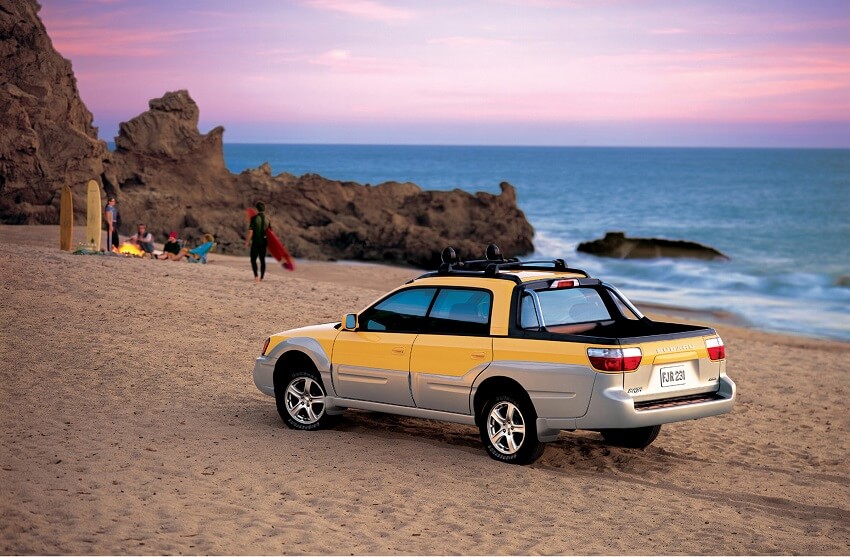Though only the 22nd largest automaker in the world, Subaru have successfully managed to carve out a nice niche for itself both in the Japanese and international markets. Particularly, the all-wheel-drive segment. “Subaru” is what the Pleiades star cluster is called in Japanese, and the company’s logo represents this with its stylised representation of seven stars.
But, how did it become the car maker it is today? OSV takes a look at the interesting history of the Japanese manufacturer.
When did Subaru start making cars?
Subaru got its start when Fuji Heavy Industries decided to branch out into car manufacturing. A large transportation conglomerate, Fuji created the Subaru division in the 1950’s. It was in 1954 that Subaru launched the 1500. The 1500 was a compact vehicle with a monocoque body, a Peugeot engine and independent front and rear suspension.
Several followed, including the Subaru 360, Japan’s first mini car. Subaru’s answer to the European mass-market “people’s cars” of the time such as the VW Beetle, the 360 was affectionately named the “ladybug” in Japan. It was one of the most popular cars in Japan and production reached 392,000 over its 12-year run.[vc_single_image image=”44595″ img_size=”article-image”]Other models following the 360 included the Sambar and the 1000. The 1000 saw the introduction of the Subaru Boxer Engine. At the heart of every Subaru, the boxer engine is so named after the horizontal movement of the pistons.
When did Nissan acquire Subaru?
During a period of government-ordered merging of the auto-industry, Nissan acquired a 20.4% stake in Fuji Heavy Industries. Interestingly, the merging came about to encourage competitiveness within the industry.
Nissan utilized FHI’s bus manufacturing capabilities for their Nissan Diesel line of buses. And, in turn, Subaru vehicles used parts by Keiretsu, the Nissan manufacturer.
Under this arrangement, Subaru launched the R-2 the Rex and Leone, the BRAT and several others.
When was Subaru sold to General Motors?
[vc_single_image image=”44596″ img_size=”article-image”]In 1999 Nissan sold their stake in FHI to General Motors. This was due to the fact that Renault had acquired Nissan.
In the time Subaru was under the instruction of General Motors they launched the Baja and the Tribeca. The Forester was sold under the Chevrolet marque in India.
However, General Motors liquidated their holdings in Fuji Heavy Industries in 2005 and a majority of the joint projects were dropped.
When did Toyota acquire Subaru?
Actually, Toyota haven’t really acquired Subaru. They bought just over 40% of General Motor’s former stock but this only amounted to 8.7% of FHI. Most of the stocks went to a stock buy-back programme.
Since then, Toyota and Subaru have collaborated on various projects including the Toyota Camry and the Exiga. In 2008 Toyota increased their share to 16.5% and entered a joint venture to develop the Toyota 86.[vc_single_image image=”44598″ img_size=”article-image”]
How did Subaru get their name?
Subaru is the Japanese name for the star cluster Pleiades, which is located in the Taurus constellation. The cluster is also known as “The Seven Sisters”. This is represented in their logo. But, you may have noticed that there are only six stars in the Subaru logo. This is because tradition says that one of them is invisible, hence the fact that there are only six stars in the logo.
Interestingly, the Pleiades cluster is among the nearest star clusters to the Earth. It’s also the cluster most obvious to the naked eye at night. But anyway, back to Subaru.
Subaru and the Environment
[vc_single_image image=”44597″ img_size=”article-image”]Subaru are pretty advanced in the automotive industry when it comes to its carbon footprint.
Their plant in Indiana was the first auto assembly plant to be awarded zero landfill status. This means that nothing from the manufacturing process in that plant goes into a landfill. They have also developed an “end-of-life” recycling plan for their cars. In fact, the recycling ratio rate for Subaru cars is an impressive 97.3% in their end-of-life vehicles.
A majority of their modern models are made with recyclable material including in the engine, suspension, transmission and pretty much everywhere else.Interestingly, the Indiana factory is the first and only plant in the US to earn the ‘National Wildlife Federation’s Backyard Wildlife Habitat Status’. The grounds are home to a range of wildlife one wouldn’t expect near a car manufacturing plant including the likes of Bald Eagles, Turtles, Rabbits, Beavers and many other fun creatures. In fact, they do so much for the environment it would take forever to list just how many things they do.
They currently offer Partial Zero Emissions Vehicle (PZEV) with models Legacy, Outback, Impreza, XV/Crosstrek and Forester.
And there we have it. Subaru aren’t the biggest manufacturer, nor the oldest, but they are still going strong. In fact, they broke their record for sales in 2015, making it their eighth successive year to do so. They also make almost 75% of their cars in Japan, standing apart from many of their Japanese competitors. Subaru are committed to driver safety and continuing to be as environmentally friendly as possible. JTNDJTIxLS1IdWJTcG90JTIwQ2FsbC10by1BY3Rpb24lMjBDb2RlJTIwLS0lM0UlMEElM0NzcGFuJTIwY2xhc3MlM0QlMjJocy1jdGEtd3JhcHBlciUyMiUyMGlkJTNEJTIyaHMtY3RhLXdyYXBwZXItZjFkMmY1NTMtZDgyZS00OGEwLTlhM2EtNGQyMjZjMmUwODk5JTIyJTNFJTBBJTIwJTIwJTIwJTIwJTNDc3BhbiUyMGNsYXNzJTNEJTIyaHMtY3RhLW5vZGUlMjBocy1jdGEtZjFkMmY1NTMtZDgyZS00OGEwLTlhM2EtNGQyMjZjMmUwODk5JTIyJTIwaWQlM0QlMjJocy1jdGEtZjFkMmY1NTMtZDgyZS00OGEwLTlhM2EtNGQyMjZjMmUwODk5JTIyJTNFJTBBJTIwJTIwJTIwJTIwJTIwJTIwJTIwJTIwJTNDJTIxLS0lNUJpZiUyMGx0ZSUyMElFJTIwOCU1RCUzRSUzQ2RpdiUyMGlkJTNEJTIyaHMtY3RhLWllLWVsZW1lbnQlMjIlM0UlM0MlMkZkaXYlM0UlM0MlMjElNUJlbmRpZiU1RC0tJTNFJTBBJTIwJTIwJTIwJTIwJTIwJTIwJTIwJTIwJTNDYSUyMGhyZWYlM0QlMjJodHRwJTNBJTJGJTJGY3RhLXJlZGlyZWN0Lmh1YnNwb3QuY29tJTJGY3RhJTJGcmVkaXJlY3QlMkYyMzgxNDkyJTJGZjFkMmY1NTMtZDgyZS00OGEwLTlhM2EtNGQyMjZjMmUwODk5JTIyJTIwJTNFJTNDaW1nJTIwY2xhc3MlM0QlMjJocy1jdGEtaW1nJTIyJTIwaWQlM0QlMjJocy1jdGEtaW1nLWYxZDJmNTUzLWQ4MmUtNDhhMC05YTNhLTRkMjI2YzJlMDg5OSUyMiUyMHN0eWxlJTNEJTIyYm9yZGVyLXdpZHRoJTNBMHB4JTNCJTIyJTIwaGVpZ2h0JTNEJTIyMTEwJTIyJTIwd2lkdGglM0QlMjI4MDAlMjIlMjBzcmMlM0QlMjJodHRwcyUzQSUyRiUyRm5vLWNhY2hlLmh1YnNwb3QuY29tJTJGY3RhJTJGZGVmYXVsdCUyRjIzODE0OTIlMkZmMWQyZjU1My1kODJlLTQ4YTAtOWEzYS00ZDIyNmMyZTA4OTkucG5nJTIyJTIwJTIwYWx0JTNEJTIyc3ViYXJ1JTIwaGlzdG9yeSUyMCUyMiUyRiUzRSUzQyUyRmElM0UlMEElMjAlMjAlMjAlMjAlM0MlMkZzcGFuJTNFJTBBJTIwJTIwJTIwJTIwJTNDc2NyaXB0JTIwY2hhcnNldCUzRCUyMnV0Zi04JTIyJTIwc3JjJTNEJTIyaHR0cHMlM0ElMkYlMkZqcy5oc2N0YS5uZXQlMkZjdGElMkZjdXJyZW50LmpzJTIyJTNFJTNDJTJGc2NyaXB0JTNFJTBBJTIwJTIwJTIwJTIwJTNDc2NyaXB0JTIwdHlwZSUzRCUyMnRleHQlMkZqYXZhc2NyaXB0JTIyJTNFJTBBJTIwJTIwJTIwJTIwJTIwJTIwJTIwJTIwaGJzcHQuY3RhLmxvYWQlMjgyMzgxNDkyJTJDJTIwJTI3ZjFkMmY1NTMtZDgyZS00OGEwLTlhM2EtNGQyMjZjMmUwODk5JTI3JTJDJTIwJTdCJTdEJTI5JTNCJTBBJTIwJTIwJTIwJTIwJTNDJTJGc2NyaXB0JTNFJTBBJTNDJTJGc3BhbiUzRSUwQSUzQyUyMS0tJTIwZW5kJTIwSHViU3BvdCUyMENhbGwtdG8tQWN0aW9uJTIwQ29kZSUyMC0tJTNFJTBB[vc_column width=”1/4″]JTNDJTIxLS1IdWJTcG90JTIwQ2FsbC10by1BY3Rpb24lMjBDb2RlJTIwLS0lM0UlMEElM0NzcGFuJTIwY2xhc3MlM0QlMjJocy1jdGEtd3JhcHBlciUyMiUyMGlkJTNEJTIyaHMtY3RhLXdyYXBwZXItZmYyMjI3OGUtMTA2ZC00YTRlLWFlNmMtNzU5NzY3YjE0NjUxJTIyJTNFJTBBJTIwJTIwJTIwJTIwJTNDc3BhbiUyMGNsYXNzJTNEJTIyaHMtY3RhLW5vZGUlMjBocy1jdGEtZmYyMjI3OGUtMTA2ZC00YTRlLWFlNmMtNzU5NzY3YjE0NjUxJTIyJTIwaWQlM0QlMjJocy1jdGEtZmYyMjI3OGUtMTA2ZC00YTRlLWFlNmMtNzU5NzY3YjE0NjUxJTIyJTNFJTBBJTIwJTIwJTIwJTIwJTIwJTIwJTIwJTIwJTNDJTIxLS0lNUJpZiUyMGx0ZSUyMElFJTIwOCU1RCUzRSUzQ2RpdiUyMGlkJTNEJTIyaHMtY3RhLWllLWVsZW1lbnQlMjIlM0UlM0MlMkZkaXYlM0UlM0MlMjElNUJlbmRpZiU1RC0tJTNFJTBBJTIwJTIwJTIwJTIwJTIwJTIwJTIwJTIwJTNDYSUyMGhyZWYlM0QlMjJodHRwJTNBJTJGJTJGY3RhLXJlZGlyZWN0Lmh1YnNwb3QuY29tJTJGY3RhJTJGcmVkaXJlY3QlMkYyMzgxNDkyJTJGZmYyMjI3OGUtMTA2ZC00YTRlLWFlNmMtNzU5NzY3YjE0NjUxJTIyJTIwJTNFJTNDaW1nJTIwY2xhc3MlM0QlMjJocy1jdGEtaW1nJTIyJTIwaWQlM0QlMjJocy1jdGEtaW1nLWZmMjIyNzhlLTEwNmQtNGE0ZS1hZTZjLTc1OTc2N2IxNDY1MSUyMiUyMHN0eWxlJTNEJTIyYm9yZGVyLXdpZHRoJTNBMHB4JTNCJTIyJTIwaGVpZ2h0JTNEJTIyMzM4JTIyJTIwd2lkdGglM0QlMjI4NTglMjIlMjBzcmMlM0QlMjJodHRwcyUzQSUyRiUyRm5vLWNhY2hlLmh1YnNwb3QuY29tJTJGY3RhJTJGZGVmYXVsdCUyRjIzODE0OTIlMkZmZjIyMjc4ZS0xMDZkLTRhNGUtYWU2Yy03NTk3NjdiMTQ2NTEucG5nJTIyJTIwJTIwYWx0JTNEJTIydWx0aW1hdGUlMjBsZWFzaW5nJTIwZ3VpZGUlMjIlMkYlM0UlM0MlMkZhJTNFJTBBJTIwJTIwJTIwJTIwJTNDJTJGc3BhbiUzRSUwQSUyMCUyMCUyMCUyMCUzQ3NjcmlwdCUyMGNoYXJzZXQlM0QlMjJ1dGYtOCUyMiUyMHNyYyUzRCUyMmh0dHBzJTNBJTJGJTJGanMuaHNjdGEubmV0JTJGY3RhJTJGY3VycmVudC5qcyUyMiUzRSUzQyUyRnNjcmlwdCUzRSUwQSUyMCUyMCUyMCUyMCUzQ3NjcmlwdCUyMHR5cGUlM0QlMjJ0ZXh0JTJGamF2YXNjcmlwdCUyMiUzRSUwQSUyMCUyMCUyMCUyMCUyMCUyMCUyMCUyMGhic3B0LmN0YS5sb2FkJTI4MjM4MTQ5MiUyQyUyMCUyN2ZmMjIyNzhlLTEwNmQtNGE0ZS1hZTZjLTc1OTc2N2IxNDY1MSUyNyUyQyUyMCU3QiU3RCUyOSUzQiUwQSUyMCUyMCUyMCUyMCUzQyUyRnNjcmlwdCUzRSUwQSUzQyUyRnNwYW4lM0UlMEElM0MlMjEtLSUyMGVuZCUyMEh1YlNwb3QlMjBDYWxsLXRvLUFjdGlvbiUyMENvZGUlMjAtLSUzRSUwQQ==[vc_column width=”1/4″]
